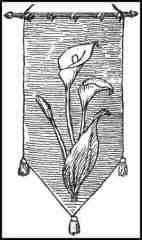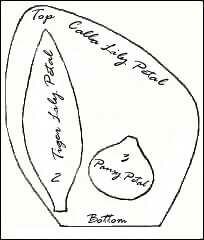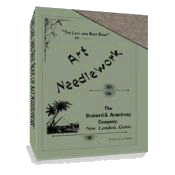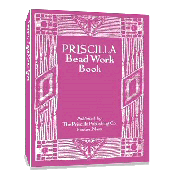Raised Embroidery Calla Lily
This Calla Lily banner is something a little different than most needlework. This is a raised embroidery used only for decoration. It should not be used on articles such as pillows or tidies as these receive wear from use.
This kind of embroidery is good for banners, mirror frames, easel pieces and other such items. It is advised that skimping, both on material or workmanship, will result in poor results, therefore, be sure to use an abundance of materials that are needed and spend the time required to do it right.
The following instructions were found in Dainty Work for Pleasure and Profit, written in 1894 and copyrighted in 1901. It was published by Thompson & Thomas. The article has been edited for use on this site.
Some materials may no longer be available. It will be up to the crafter of this item to decide what current products are best suited as replacement materials.
Calla Lily

Click on image to see more detail.
For banners or easel pieces there is no flower more effective than the calla lily, and better than almost any other flower does it lend itself to raised effects. The background should be of plush or velvet, and the color should be rich and warm. A deep blue, crimson or green will throw the raised calla lilies into relief.
In putting the design upon the material, stamp on only the leaves and stems; do not stamp the flowers. The material required for making one calla lily will be as follows: One square foot of screen wire – the finest mesh made – this can be procured at any hardware store; four dozen skeins cream white arrasene; one calla center, one skein light olive green chenille, one arrasene needle, one piece wash blond*. The wire will be sufficient for two calla lilies and one bud, but less cannot be purchased. Cut a piece of the wire into shape by the calla pattern below, cut with a pair of sharp shears, so as to get a good, clear edge. Cover this wire calla on both sides with the wash blond and secure with a few stitches. You are now ready to work the calla lily.

Click on image to see more detail.
Thread the arrasene needle with a strand of the white arrasene. Begin at the top point of the flower and work over the edge, down one side; return to the top of flower again and work down the opposite side, taking the stitch in to a depth of at least one to two inches.
This operation will give a smooth, even edge to the flower, alike on both sides, and is worked as follows: Bring the needle up from the top of the wire about two inches from the top edge; throw the read over the edge and bring the needle up again from the back.
Repeat until the edge of the flower has been worked. After this part of the work has been completed, begin to cover the wire on one side by filling in toward the center with several rows of short and long stitches, being careful to work both halves of the wire shape so evenly that there shall be no perceptible joining in the center, but the entire calla lily shall present a smooth even surface.
This completed, turned the wire shape over and work in the same manner on the reverse side.
In working, twist the arrasene in the needle. When the wire has been smoothly and solidly covered with the arrasene stitches on both sides, take the calla between the thumb and finger on one hand, near the top of the flower, and with the other fold it into shape, after the fashion of twisting a cornucopia; the wire is stiff and will retain the shape without trouble.
Place the calla in position on the background and secure with a single stitch at the top and one at the base of the flower. This will be sufficient to hold it in place. Slip the calla center into position and catch with a stitch.
With the green chenille, work the calyx of calla, carrying the stitches well up on the outside of the flower, working quite heavy at the base. This throws the flower into relief and gives it a rich effect.
The stems of the calla should be worked with solid Kensington stitch.
Sometimes the calla is made of fine chenille instead of the arrasene, but it is never so satisfactory.
The figure located immediately under the title of this page shows a raised calla applied to a moss green plush banner, and will give an idea of grouping. These raised callas are very beautiful for Easter decorations.
For those who do not know what Wash-Blonde is:
Definition: *Wash-Blonde. A name given to a species of narrow bobbinet or Brussels net, suitable for quillings. It was formerly produced from unbleached cotton and was termed Nankin and blonde net, from its yellow or blonde color. At present the material is dyed in several tints and distinguished by its narrow width. The quality of wash blonde, as well as of Brussels net, depends upon the smallness of the meshes, their equality in size, fineness of yarn, and the regularity of the hexagons.
- Definition from A Complete Dictionary of Dry Goods,
by George S. Cole, 1892
Return to top of Calla Lily page
Return to Types of Embroidery page.
Return to Special Designs page.
The Last and Best Book of Art Needlework
Over 100 pages of authentic Victorian instructions and patterns from 1895!
FREE
Beeton's Book Of Needlework

433 pages!
Sign up for VEAC! Everything you wanted to know about Victorian embroidery, needlework, crafts and more!
Priscilla Bead Work Book
Make Beautiful Victorian Beaded Purses, Jewelry & Accessories - Starting
TODAY!



